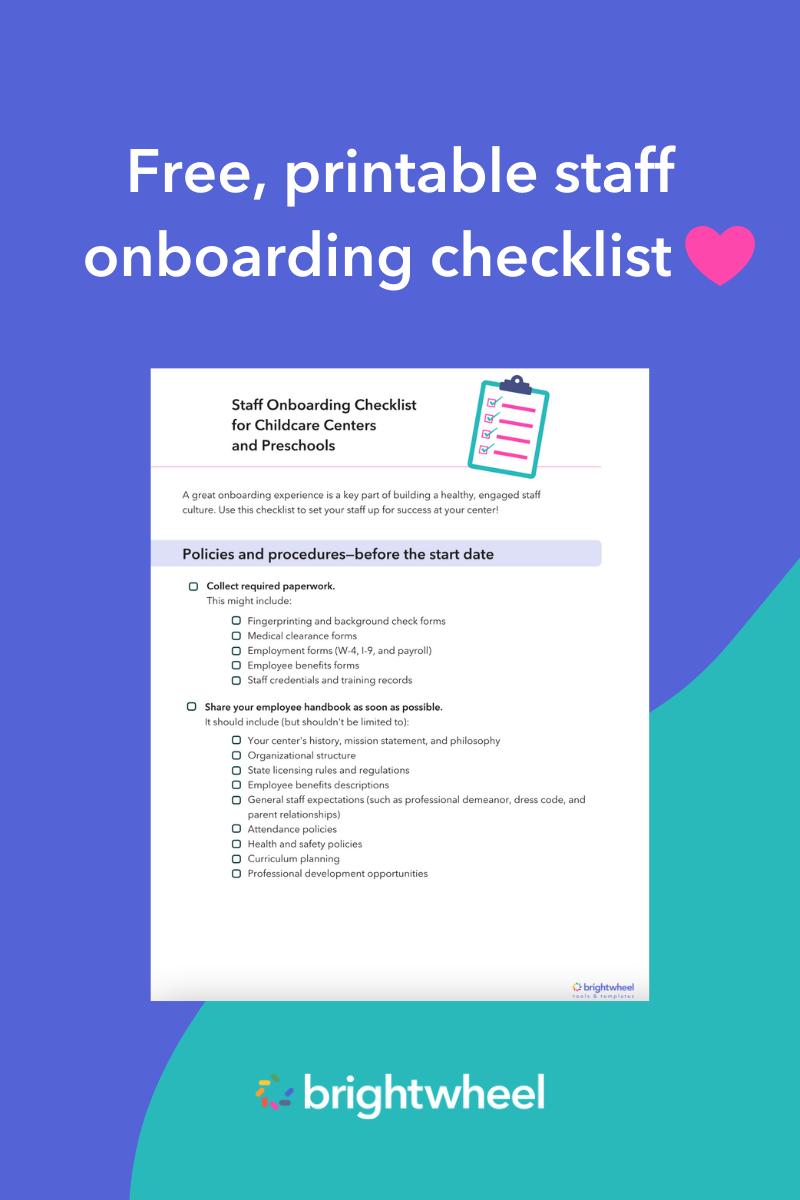
Building a healthy staff culture at your childcare center or preschool doesn’t happen overnight. It’s an ongoing process that starts as soon as your staff members accept their job offers—and a successful onboarding process can set the tone for a positive working environment. Creating an onboarding process can help new teachers feel well-equipped, connected with other staff, and excited to start working. You can use an onboarding checklist to organize your process and build a collaborative and supportive work culture as you prepare new hires for their roles at your preschool or childcare center.
What is onboarding?
Onboarding is the process of introducing new hires to your childcare center or preschool and helping them adjust to their role. The onboarding process often includes providing your new hires with an employee handbook, explaining your center’s policies and procedures, giving them an orientation, and introducing them to your other staff.
A thorough onboarding process typically takes place over a new employee’s first 90 days or three months and plays a key role in the hiring process. During this time you can share details about your company mission and values, set expectations and goals with your employees, and continue to provide training.

Why is onboarding important?
Onboarding gives new hires the information, training, and support they need to carry out their duties effectively and confidently and helps them become immersed in your center’s culture. A successful onboarding process can motivate your current staff and help your childcare center retain employees. Employees can understand how their skills and job responsibilities align with the company’s vision and contribute to the overall success of the business.
From a business perspective, an onboarding checklist can also help streamline your hiring and training process, allowing supervisors to organize important onboarding documents such as background check forms, benefit documents, and important policy and procedure information.
How to onboard a new employee
Follow the below onboarding checklist to prepare new employees for their roles at your childcare center or preschool:
1. Share your employee handbook as soon as possible
Once a new staff member has accepted their job offer, it’s never too early to send them your employee handbook. The sooner you share it with new teachers, the more time they’ll have to absorb everything they need to know before their official start date.
Your employee handbook can include:
- Your center’s history, mission statement, and philosophy
- Organizational structure
- State licensing rules and regulations
- Employee benefit information
- General staff expectations (such as professional demeanor, dress code, and family relationships)
- Attendance policies
- Health and safety policies
- Curriculum planning
- Professional development opportunities
- Any other important information that you would like to share with new hires
Because your handbook contains a lot of new information, remind staff that you’re available to answer any questions they have about your policies and procedures, even before their first day of work. This will establish open lines of communication with your teachers from the beginning!
2. Host an orientation day if you have multiple new hires
If you have more than a few new staff members joining your center simultaneously, consider hosting an orientation day to review your employee handbook. In addition to covering key logistics, make sure to also share information that will inspire your new staff and get them excited to start working. This can be as simple as talking about your center’s history, teaching philosophies, or real-life stories about how you’ve made a difference for children and families.
You can also include a few team building activities in your agenda. Simple icebreaker questions such as “What was your favorite childhood book?” can be a great way to kick off your meeting and help your staff feel more comfortable with each other.
3. Give a tour of your facilities
It can be very disorienting to start a new job in an unfamiliar space. Beyond showing your new teachers where their classrooms are, lead them on a tour of your entire facility so they know their way around your center before their first day.
Make sure your tour covers the following information:
- Main classroom responsibilities
- Emergency exits and procedures
- Cleaning protocols
- Daily schedules and breaks
- Drop-off and pick-up procedures
- Parking information
4. Have new staff shadow a teacher or observe a classroom
Early educators know this best—sometimes, the best way to learn something new is to watch someone else do it! Have your new staff shadow another teacher for a day or observe a classroom before they start working with children. You can also host a debriefing session afterward to discuss what your staff learned and answer any questions they have.
5. Host a welcome gathering
Making sure your new staff feels connected with your team is a key (and often overlooked) part of a great onboarding experience. Within your new teachers’ first couple of weeks, plan a welcome gathering and invite your entire staff team.
Here are some ideas for fun activities that can help your staff bond:
- Breakfast waffle bar or smoothie bar
- Picnic or barbecue
- Team outing to get coffee and pastries
- Staff potluck
- Team hike or park hangout
6. Assign staff mentors or buddies
While it’s important to be available to your new teachers during onboarding, your staff team can also pitch in and help their new colleagues get acclimated. This will lighten your workload (especially if you have multiple new hires) and remind your new teachers that your staff team can support them greatly.
Pair your new staff with experienced teachers so they always have someone to go to if they have questions or need help. Consider giving each pair a small budget for coffee or treats so they can take fun breaks together to check in.
7. Set up frequent 1:1 check-ins during your staff’s first month
It’s important to meet with your staff regularly so they feel supported, especially in their first few months. You may want to set up weekly check-ins to start and transition to meeting less frequently once they get more comfortable in their roles.
Here are some topics you can cover in your check-ins:
- What’s going well
- What’s difficult or challenging
- Areas of improvement you see
- Their career goals and how you can support their growth
- Upcoming professional development opportunities
You can also let your new teachers know that you have an open door policy and that they don’t need to wait until a formal check-in if they have a pressing question for you.
8. Help new staff connect with families
Another way to help new teachers get comfortable is to provide opportunities for them to connect with the families in your program. You can use a tool like brightwheel’s communication feature to send messages to your families introducing them to your new staff and encouraging them to say hello at their next drop-off or pick-up. You can also share a “new teacher spotlight” on social media or in your center’s newsletter so families can get to know them better.
Final thoughts
Onboarding new hires is essential for running a successful preschool or childcare center. Following these tips can help you give your new hires the support and tools they need to understand your center’s procedures, acclimate to their roles, and feel like valued staff members.


